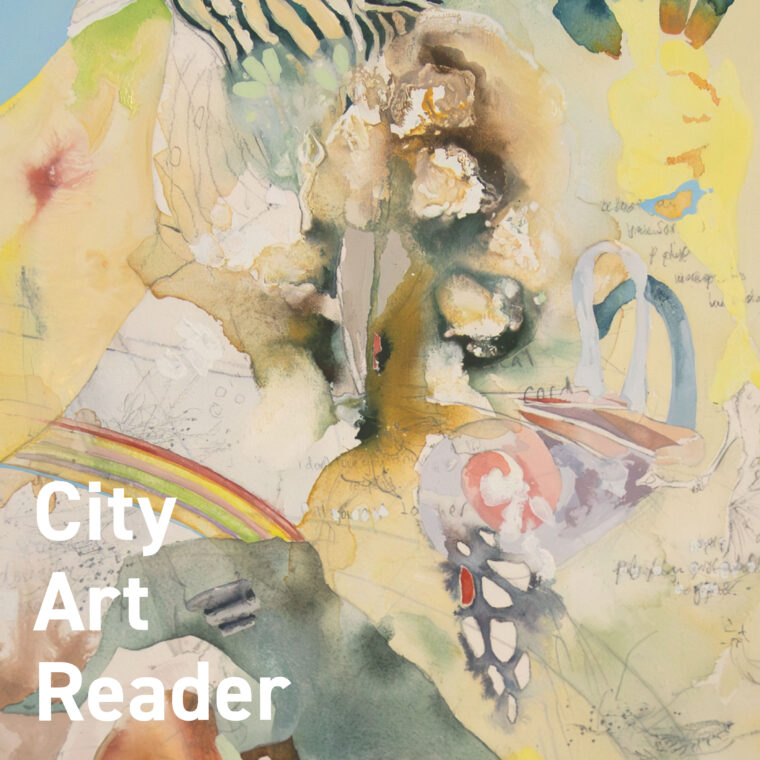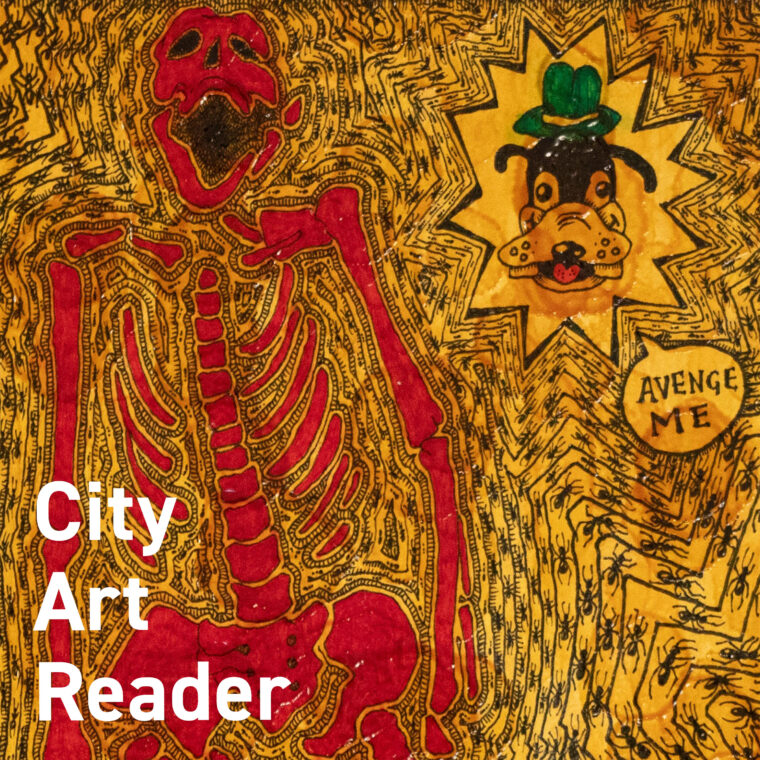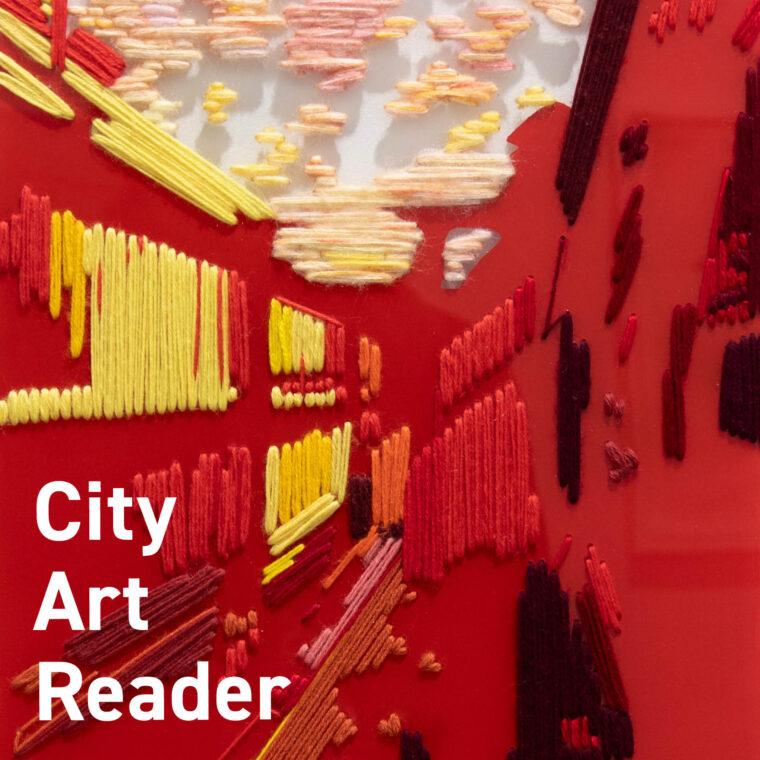Clare Logan is an Ōtautahi Christchurch-based artist whose paintings are formed through the pouring and manipulating of paint in true expressions of movement. Logan immerses herself in a distinctively poetic approach to how landscapes are created both in painting and in the forces of nature that flow through, carve and weather the natural world. Ahead of her exhibition Weathering at City Art Depot she spoke with City Art Reader editor Cameron Ralston in her Tai Tapu studio. Weathering opens 5:30-7pm Tuesday 12 August and runs through to 1 September 2025.

Half sun, oil on board, 1000x800mm, 2025
Cameron Ralston: Tell me about the title for this body of work – Weathering.
Clare Logan: As a title it has a number of meanings and allusions, qualities I like in a title. With these works I’ve been thinking particularly about wanting them to hold a sense of both lightness and density at the same time. ‘Weathering’ felt like it could capture both of those things. It can hold allusions to weather systems, maybe those that bring ephemeral wind gusts, rain or vapours. Then I was thinking about the weathering of stone and deep time. I think there’s a bit of a human and emotional quality to it as well – maybe emotional weathering through a life.
Do you feel a personal weathering, in terms of maturing as a person and an artist?
I think so. As I live longer and experience more, there’s a weathering. I often look to the natural world for metaphor, to make sense of a life.
Is there a connection you find within that to a base level of being human?
I think at the core of a lot of what I do is a fascination and ongoing wrestling with what it is to be in a body and to be made of matter, the stuff that’s all around us. And what it is to also be a feeling, thinking, sensing thing.
That could be seen to relate to the visual quality of the works, in the bleeding and fluidity of forms. Are there things that you’re trying to imbue your works with to capture those notions?
I think so, but that that happens on a very intuitive level, where something will happen with the paint or the forms and something in me just clicks and I feel, ‘That’s right, keep pursuing that thing, because that’s getting at it.’ Getting at the bigger thing in some way.

The moving curtain, oil on board, 840x725mm, 2025
A large part of what informs your artwork is the time you spend in nature. I’m curious as to how you translate those experiences into the paintings.
When I’m outdoors, in the hills or mountainous environments, I do a lot of looking – at the terrain, the light, the matter-ness of the landscape. Looking at where there are marks and remnants of movement or ruptures, things that are the result of shifts like how a scree might curve a particular way. I want to use the word rhythms – visual rhythms in the landscape. That might be an artefact of something cataclysmic or storming, something that might have happened to change things, and that’s what’s left. And those are the things that really inspire some of the rhythms that I try and create in my own work. I suppose I do enact on a small-scale flows and ruptures with the way I use paint, with how the pigment disperses and coalesces over the panels. I feel fascinated, watching what happens.
Are these artworks informed by any particular experiences you’ve had?
Not specifically – I think in a general sense, my physical forays outside, and the observations, just end up kind of in me and unconsciously informing the works.
Do you see evolution or change in your practice?
I think my work is an ever-unfolding thing. I know it has shifted from older work, but that doesn’t happen in a particularly strategic way. I think it just happens through continuing to live and see what happens for me personally, where my interests take me, how things unfold. Yeah, it’s an ongoing unfolding thing that I can’t predict. I tend to pick up something from a body of work that felt particularly interesting, or on a feeling and intuiting level as the next right thing. Or there’s something there that I want to keep disentangling and see where it takes me. I just trust that and follow. On a technical and practical level, I’m always trying to push the experimentation in different directions and see what happens if I start playing with the materials in a slightly different way. I like to be surprised and engaged in the process.
This work, Exhalation, you had in a show at the Stoddart Cottage at the start of the year. You’ve mentioned to me that this painting was a sort of starting point.
That work to me had a particular quality of airiness, against the material density of the support and the paint, that I found interesting and that I wanted to try and pursue. So yeah, I think in that way it was kind of the tether for the show because it really got me thinking about that particular tension and how I could see it play out further.

Exhalation, oil on board, 1000x800mm, 2025
Yes, it doesn’t feel separate from the rest of the body of work. I get the sense that you paint in a kind of continuum, rather than show to show.
I’m enjoying seeing it with the other works. I think you’re right, it is a continuum. That’s the experience of making it. I just kind of make and make and make and then will arrive at a show and think, what’s the group here that best reflects where that continuum is at?
Your work is often informed within that continuum by other art forms or media you’ve been engaged with at the time. Is there any reading or writing you’ve been doing?
I haven’t been writing much this year. Been reading a lot. I’ve got it with me here, this great little book of William Blake illuminated books. The works inside are high drama.
What do you take from this?
I love his forms, the way he fits forms in a frame. The flowing quality in the dark and light, the pursuit of the transcendent.
Yeah, there’s a lot of those same qualities in your work and in the pulling and stretching of forms.
Writers like Annie Dillard continue to be very important to me. I encountered the poetry of May Swenson this year as well. One of her poems, The Beam, speaks to a lot of the things that I think about with my work.
As you move deeper into abstraction? Do you think your work has a different pull or elicits a different reaction?
I think probably it appeals more to the feeling side of the spectrum. Older works are still abstract paintings, but I suppose people might experience them more as landscapes. But to me the paintings in this show still could be experienced as landscapes.
When you look at other Aotearoa New Zealand landscape artists, do you get a sense of your work fitting in with that trajectory? I know we’ve compared your painting to the work of Petrus van der Velden for example. Their paintings elicit this kind of majesty and mystery of nature. They’re unlike a typical vision of a landscape.
Yeah, maybe some of my work. When I think of van der Velden I think of the dark Otira Gorge paintings in particular. I like his use of black – the shadows and looming, jutting forms. I find that use of black to be grounding in a painting, a kind of fertile void.
You’ve been painting on paper again for this exhibition. Has there been a further refining of that process?
Those works on paper that I showed last year were mostly ink. I’d sort of manipulated them with pouring water on in various ways. It was so mercurial, such a tricky thing, and I’ve carried on experimenting with it. Here I’ve just tried doing a single layer of a really thin oil paint glaze over the ink drawing base. I’ve really liked the results, particularly where the lightness that comes from paper underneath shines through.

Membrane (blooming), oil on paper, 480x360mm, 2025



